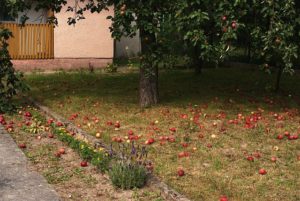7 Tactics for Planting Fruit Trees in an HOA Community

HOA’s or Home Owner’s Associations have become increasingly more prevalent, especially in the Southwest United States. The Phoenix, Arizona area where I reside, has become a haven for HOA communities.
When we were shopping for our home in 2016, the majority of homes we looked at where in HOA’s and we eventually ended up purchasing a home in one of these communities. Within these communities are regulations that are pertinent to gardeners. Many restrictions are placed, mainly on front yard landscaping with the types of plants and trees that can be utilized.
What is an HOA? A homeowners association or otherwise known as HOA are responsible for providing oversight to common areas within a community. HOA is a legal entity with a governing body that enforces the rules of the community with its members. Homeowners within an HOA pay monthly fees that go towards landscaping or neighborhood maintenance. If HOA rules and guidelines aren’t adhered to then there can be penalties that could ultimately lead to foreclosure on your home.
What are commonly banned Fruit trees for HOA’s?
It’s fairly common for many types of fruit trees to be banned from the front yards of HOA’s. I speak more for HOA communities in the Southwest. Fruit trees are a bit more maintenance then designated trees that serve an ornamental value. With fruit trees it can require pruning, higher water needs, regular fertilizing, making sure the fruit is harvested and completely removed.
RELATED POST: Maintaining Healthy Fruit Trees in Hot Climates
It’s great that your willing to do the work to keep your fruit trees in peak condition, but what about when the house is sold? A lot of times a new homeowner has no idea how to care for a fruit tree, so it then becomes an eyesore. HOA’s want the upkeep of the community looking at its best to ensure that property values are kept up.
Some of the most common fruit trees banned are Mulberries, Olives, and Citrus. Some of these trees can get quite large, have messy roots, get a bad rep for causing allergens, or worries of invasive roots. Check out my post: Smart Strategies for Fruit Trees with Invasive Roots.
How can I get around all the gardening restrictions that come with living in an HOA?

Even though HOA’s can have stringent regulation for us plant lovers, there are still some ways around the red tape. Maybe you get lucky and end up in a community where the HOA is more lenient, if not here are some options to consider:
Don’t Live in an HOA
The easiest way to avoid some of the restrictions from an HOA is to not live in one. I’m not trying to bash HOA’s, but if planting 20 fruit trees in your fruit yard is what you intend to do regardless of what anyone says, then it’s probably a good idea to skip the HOA in your home search. There are going to be other options out there that will meet your needs. HOA’s aren’t for everyone.
Know the Guidelines before you Buy
Every HOA is going to have a different set of rule and regulations, known as CC&R (Covenants, Conditions & Restrictions.) These are available for your reading enjoyment before you make your home purchase and I highly recommend reading them.
One may assume that even if you sacrifice the front yard for whatever the HOA wants, you can do whatever you’d like to that backyard. Well, that isn’t always the case. Some of the HOA’s that I looked at even had guidelines for backyard planting. In my opinion, that’s going too far.
Needless to say, I didn’t purchase in those HOA communities. Our current rules state that rear yard landscaping doesn’t need committee approval.
Ask Around
Check with some of the residents of the HOA to ask about their experiences with the HOA. Many will gladly give you their opinion for better or worse on what type of community they live in.
If you have a lot of negative reactions regarding how the community is managed, then it’s something to take into consideration. Unfortunately, everyone isn’t a plant lover, but you’ll probably run into someone who is, and they can share their experiences with trying to plant a fruit tree in their HOA.
Utilize Edible Native Plants
HOA’s in the Southwest require low water use plant and trees. In Phoenix, it can consist of cacti or other native type plants. A lot of HOA’s have a certain number requirement for how many plants and trees needed in your front yard. Some cactus produce edible fruits that can be made for jams or jellies.
The Peruvian Apple or Prickly Pear cactus produce edible fruit that may be a good alternative to meet HOA needs. You may be able to get by with a Pomegranate or Jujube since they’re low water use when established. Some HOA’s have a list of banned and approved plants, while others are more open to submitting for approval.
Container Garden in Front
If you are meeting the landscape guidelines, it can be easy to slip a few extra container fruit trees or edible shrubs, as long as you keep them looking nice. If it’s something that is cold sensitive just bring it indoors for the winter or cold nights.
Various pots can be very decretive and add beauty to the landscape which HOA’s will appreciate. Keep your container plants well maintained, as it may take some extra work on your part.
RELATED POST: Growing Fruit Trees in Containers in Hot Climates
Abide by the Code
If approved to plant a fruit tree by the HOA, follow the landscape guidelines. If you set the example of showing why fruit trees can look good for the neighborhood, as well as be an asset for your family, it becomes a win-win.
When one person can create a positive experience, it can open doors for others. Ensure that you are properly maintaining your fruit tree and utilizing features like rock or tree wells that coordinate with your yard scheme.
Change the Rules
If you’re currently unhappy with any of your HOA rules and regulations, you can push for change. With the growing movement for urban gardening and homesteading more and more homeowners can have their voices heard.
It’s not going to happen overnight, but anything is possible. Study your governing documents, CC&R, and all rules. Be willing to compromise. Instead of petitioning to plant those 20 fruit trees in the front yard, work on being able to add one. Get signatures from other homeowners to have support. Present at a board meeting and be part of the board.
Final Thoughts
HOA’s aren’t for everyone. It definitely helps to know what you’re getting yourself into and reading the fine print before making a purchase. If you’re a gardener that wants free reign on their entire property, then it’s best to look elsewhere.
If you’re willing to maintain the look of the community in the front yard, while transforming your backyard into an urban garden oasis, then HOA’s don’t have to deter you from finding a great home for your needs.
Please comment below on anything that you’ve enjoyed from this post or experiences growing fruit trees in an HOA.
